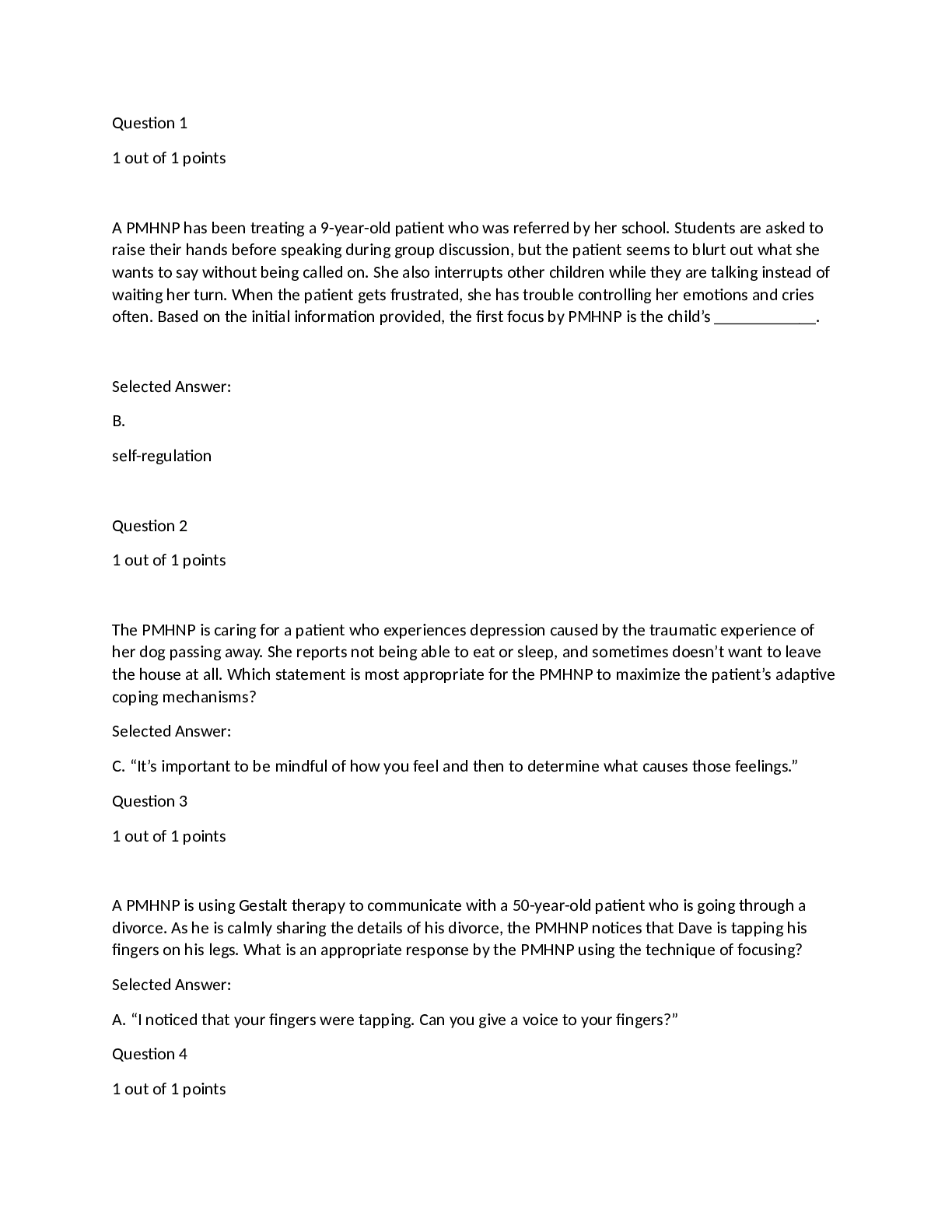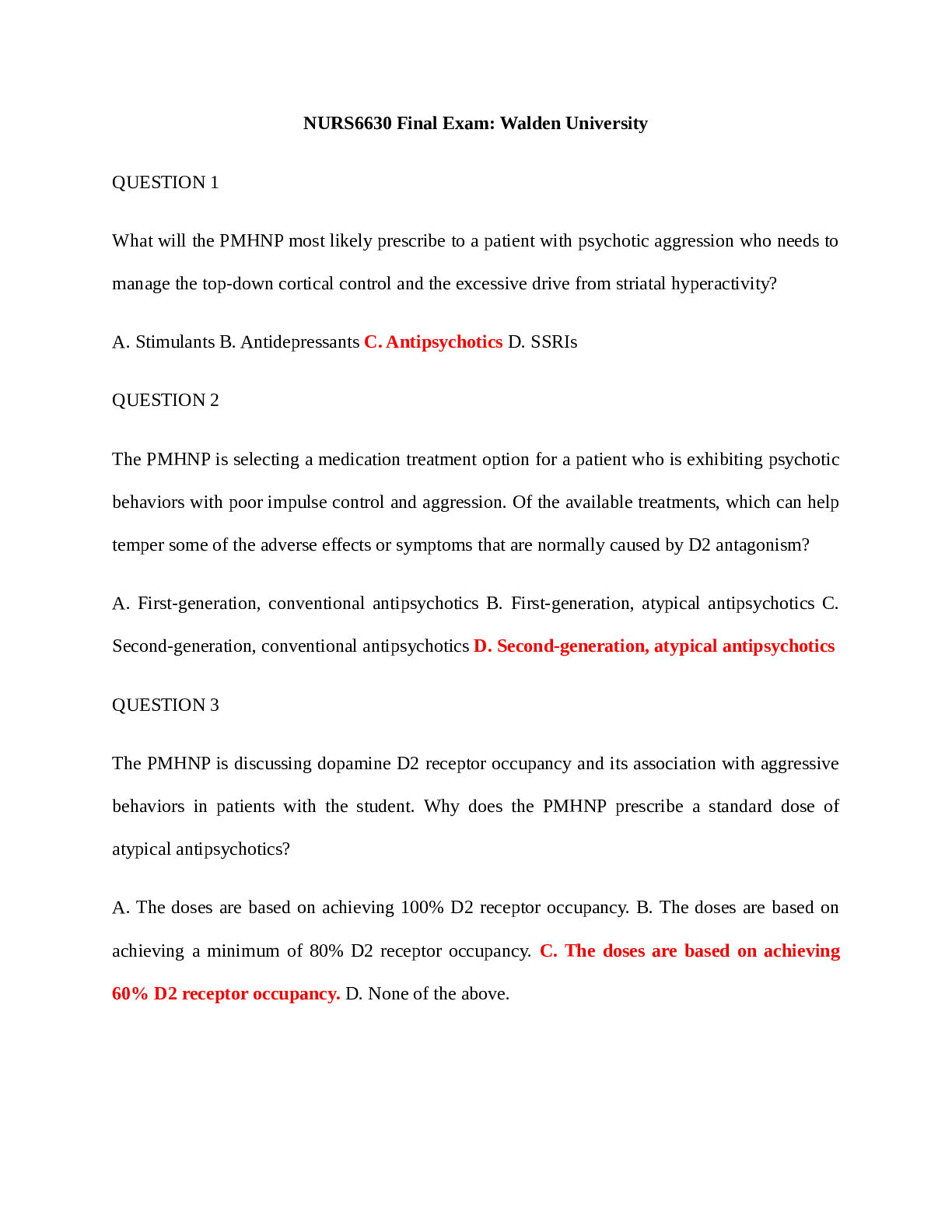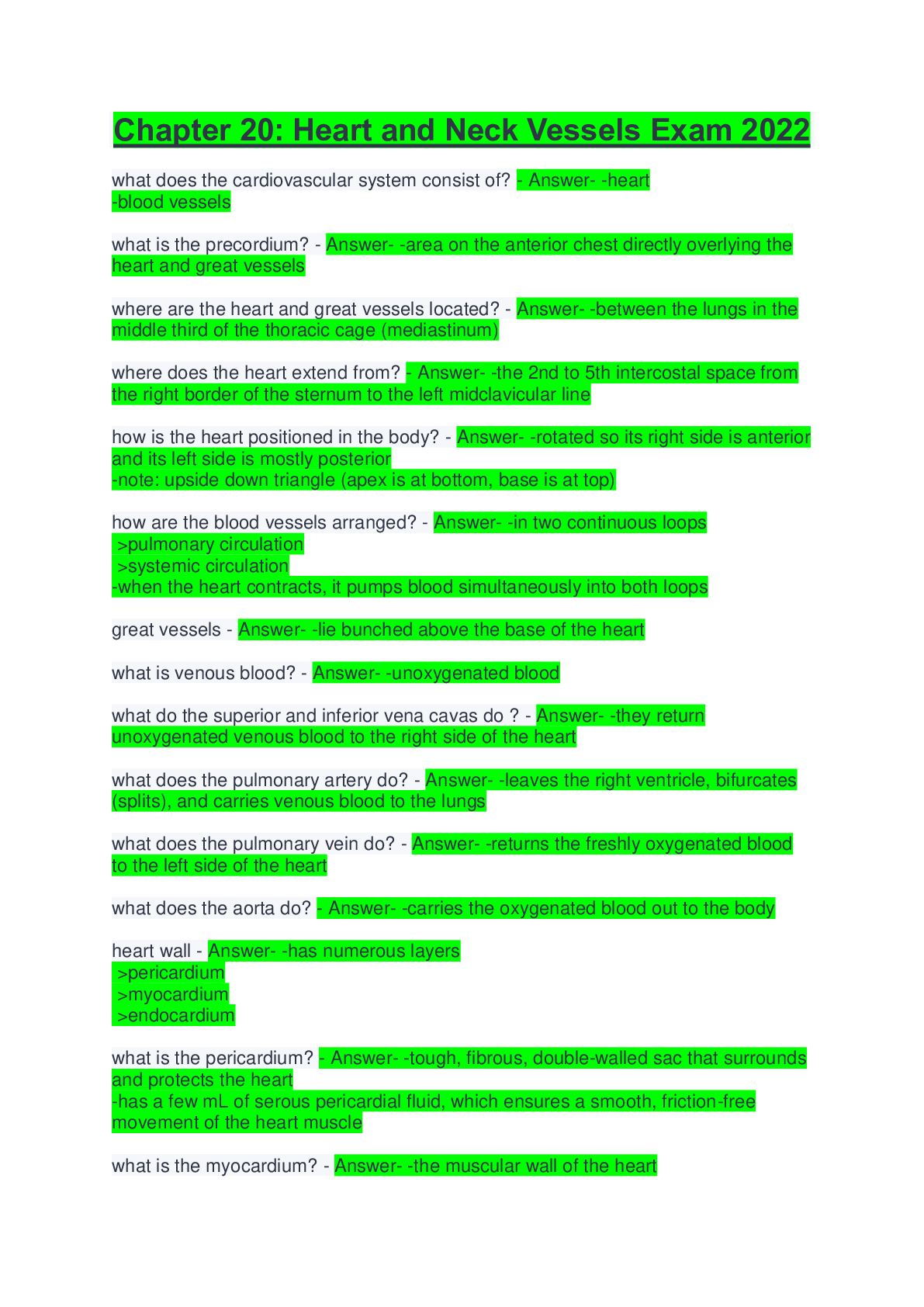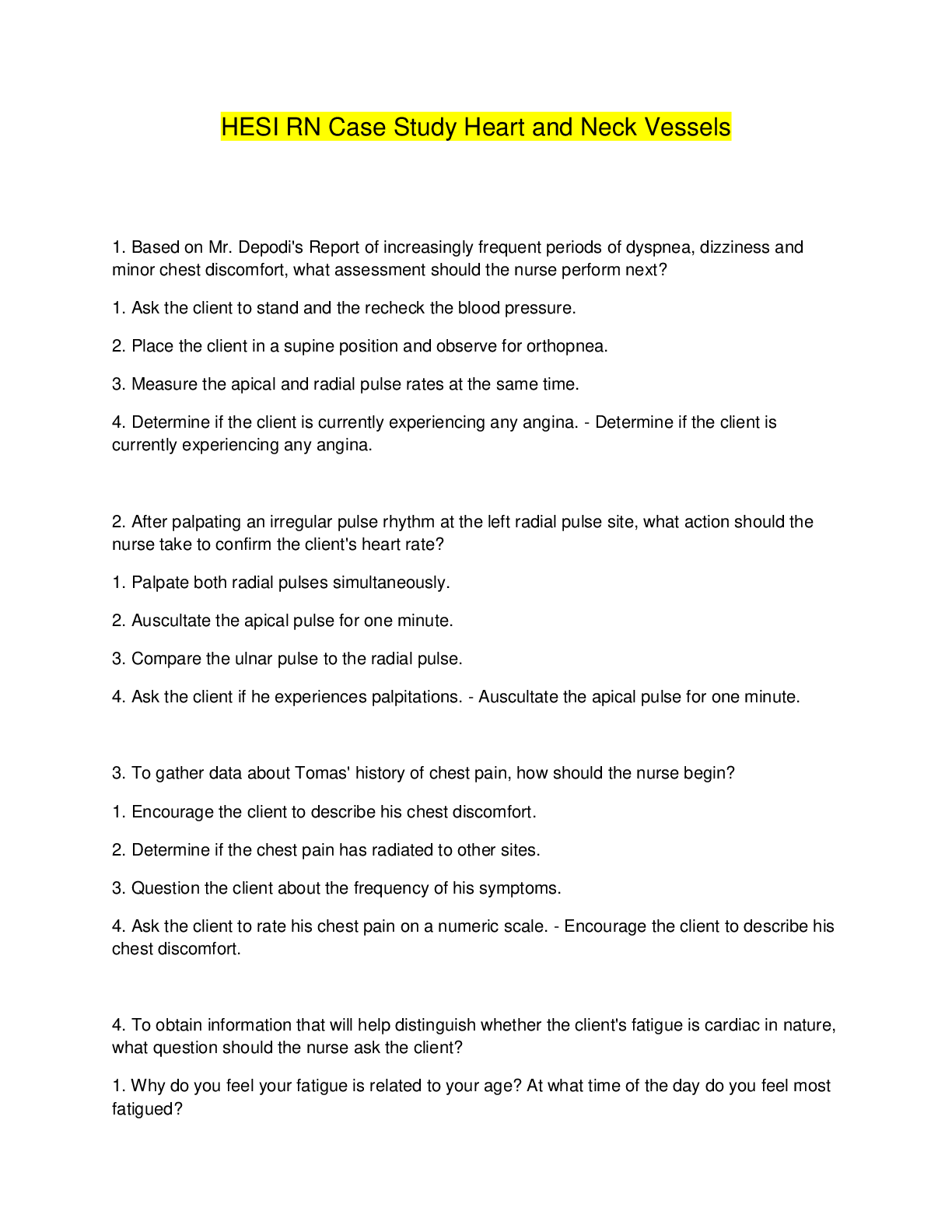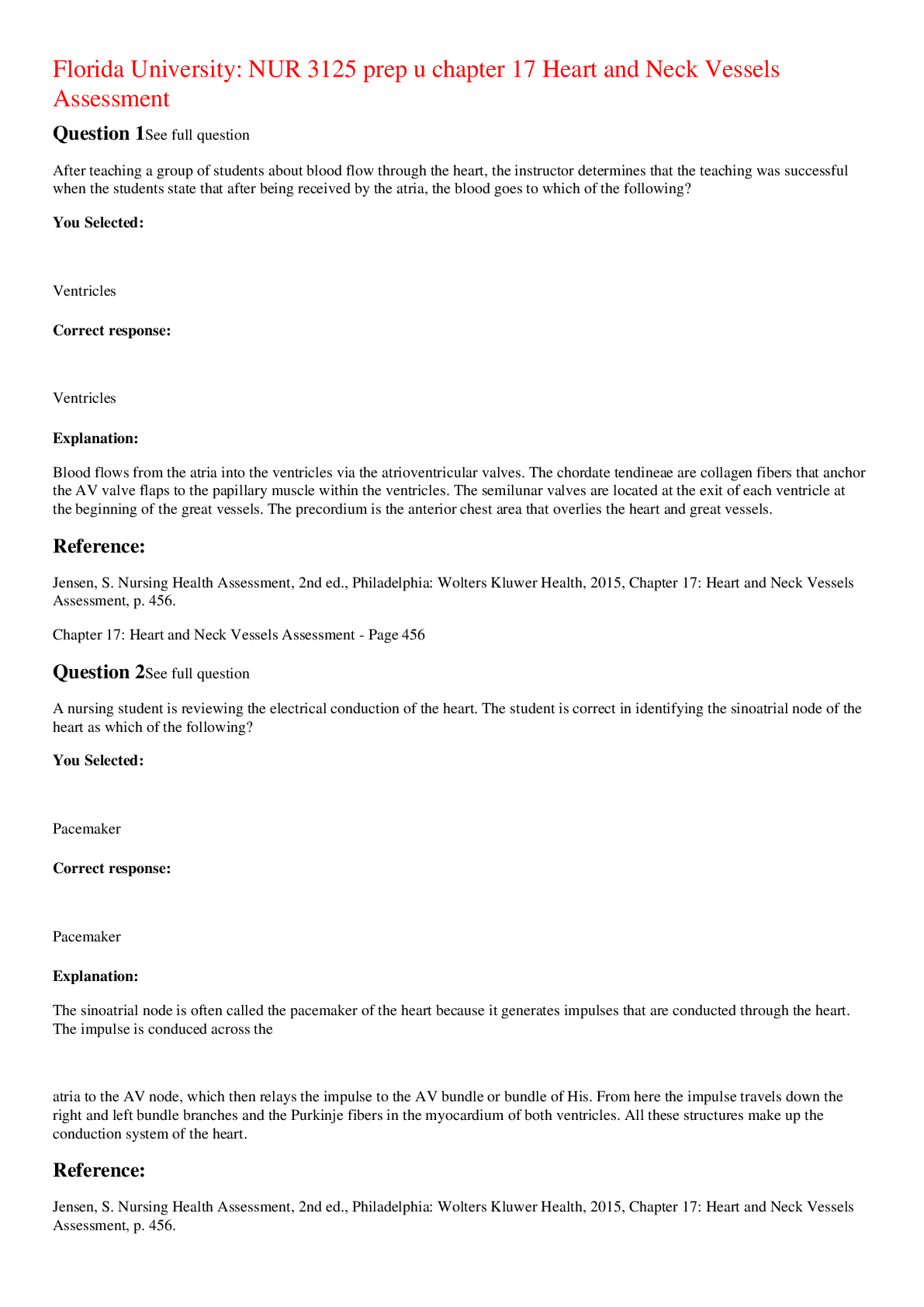nr 509 week 4 exam- Heart and Neck Vessels (latest update)
Document Content and Description Below
nr 509 week 4 exam- Heart and Neck Vessels (latest update)Week 4 Chapter 19: Heart and Neck Vessels 1. The sac that surrounds and protects the heart is called the: a. Pericardium. b. Myocardium. ... c. Endocardium. d. Pleural space. 2. The direction of blood flow through the heart is best described by which of these? a. Vena cava right atrium right ventricle lungs pulmonary artery left atrium left ventricle b. Right atrium right ventricle pulmonary artery lungs pulmonary vein left atrium left ventricle c. Aorta right atrium right ventricle lungs pulmonary vein left atrium left ventricle vena cava d. Right atrium right ventricle pulmonary vein lungs pulmonary artery left atrium left ventricle 3. The nurse is reviewing the anatomy and physiologic functioning of the heart. Which statement best describes what is meant by atrial kick? a. The atria contract during systole and attempt to push against closed valves. b. Contraction of the atria at the beginning of diastole can be felt as a palpitation. c. Atrial kick is the pressure exerted against the atria as the ventricles contract during systole. d. The atria contract toward the end of diastole and push the remaining blood into the ventricles. 4. When listening to heart sounds, the nurse knows the valve closures that can be heard best at the base of the heart are: a. Mitral and tricuspid. b. Tricuspid and aortic. c. Aortic and pulmonic. d. Mitral and pulmonic. 5. Which of these statements describes the closure of the valves in a normal cardiac cycle? a. The aortic valve closes slightly before the tricuspid valve. b. The pulmonic valve closes slightly before the aortic valve. c. The tricuspid valve closes slightly later than the mitral valve. d. Both the tricuspid and pulmonic valves close at the same time. 6. The component of the conduction system referred to as the pacemaker of the heart is the: a. Atrioventricular (AV) node. b. Sinoatrial (SA) node. c. Bundle of His. d. Bundle branches. 7. The electrical stimulus of the cardiac cycle follows which sequence? a. AV node SA node bundle of His b. Bundle of His AV node SA node c. SA node AV node bundle of His bundle branches * correct answer! d. AV node SA node bundle of His bundle branches- bank answer- IS WRONG! 8. The findings from an assessment of a 70-year-old patient with swelling in his ankles include jugular venous pulsations 5 cm above the sternal angle when the head of his bed is elevated 45 degrees. The nurse knows that this finding indicates: a. Decreased fluid volume. b. Increased cardiac output. c. Narrowing of jugular veins. d. Elevated pressure related to heart failure. 9. When assessing a newborn infant who is 5 minutes old, the nurse knows which of these statements to be true? a. The left ventricle is larger and weighs more than the right ventricle. b. The circulation of a newborn is identical to that of an adult. c. Blood can flow into the left side of the heart through an opening in the atrial septum. d. The foramen ovale closes just minutes before birth, and the ductus arteriosus closes immediately after. 10. A 25-year-old woman in her fifth month of pregnancy has a blood pressure of 100/70 mm Hg. In reviewing her previous examination, the nurse notes that her blood pressure in her second month was 124/80 mm Hg. In evaluating this change, what does the nurse know to be true? a. This decline in blood pressure is the result of peripheral vasodilatation and is an expected change. b. Because of increased cardiac output, the blood pressure should be higher at this time. c. This change in blood pressure is not an expected finding because it means a decrease in cardiac output. d. This decline in blood pressure means a decrease in circulating blood volume, which is dangerous for the fetus. 11. In assessing a 70-year-old man, the nurse finds the following: blood pressure 140/100 mm Hg; heart rate 104 beats per minute and slightly irregular; and the split S2 heart sound. Which of these findings can be explained by expected hemodynamic changes related to age? a. Increase in resting heart rate b. Increase in systolic blood pressure c. Decrease in diastolic blood pressure d. Increase in diastolic blood pressure 12. A 45-year-old man is in the clinic for a routine physical examination. During the recording of his health history, the patient states that he has been having difficulty sleeping. I'll be sleeping great, and then I wake up and feel like I cant get my breath. The nurse's best response to this would be: a. When was your last electrocardiogram? b. It's probably because its been so hot at night. c. Do you have any history of problems with your heart? d. Have you had a recent sinus infection or upper respiratory infection? 13. In assessing a patient's major risk factors for heart disease, which would the nurse want to include when taking a history? a. Family history, hypertension, stress, and age b. Personality type, high cholesterol, diabetes, and smoking c. Smoking, hypertension, obesity, diabetes, and high cholesterol d. Alcohol consumption, obesity, diabetes, stress, and high cholesterol 14. The mother of a 3-month-old infant states that her baby has not been gaining weight. With further questioning, the nurse finds that the infant falls asleep after nursing and wakes up after a short time, hungry again. What other information would the nurse want to have? a. Infants sleeping position b. Sibling history of eating disorders c. Amount of background noise when eating d. Presence of dyspnea or diaphoresis when sucking 15. In assessing the carotid arteries of an older patient with cardiovascular disease, the nurse would: a. Palpate the artery in the upper one third of the neck. b. Listen with the bell of the stethoscope to assess for bruits. c. Simultaneously palpate both arteries to compare amplitude. d. Instruct the patient to take slow deep breaths during auscultation. 16. During an assessment of a 68-year-old man with a recent onset of right-sided weakness, the nurse hears a blowing, swishing sound with the bell of the stethoscope over the left carotid artery. This finding would indicate: a. Valvular disorder. b. Blood flow turbulence. c. Fluid volume overload. d. Ventricular hypertrophy. 17. During an inspection of the precordium of an adult patient, the nurse notices the chest moving in a forceful manner along the sternal border. This finding most likely suggests a(n): a. Normal heart. b. Systolic murmur. c. Enlargement of the left ventricle. d. Enlargement of the right ventricle. 18. During an assessment of a healthy adult, where would the nurse expect to palpate the apical impulse? a. Third left intercostal space at the midclavicular line b. Fourth left intercostal space at the sternal border c. Fourth left intercostal space at the anterior axillary line d. Fifth left intercostal space at the midclavicular line 19. The nurse is examining a patient who has possible cardiac enlargement. Which statement about percussion of the heart is true? a. Percussion is a useful tool for outlining the hearts borders. b. Percussion is easier in patients who are obese. c. Studies show that percussed cardiac borders do not correlate well with the true cardiac border. d. Only expert health care providers should attempt percussion of the heart. 20. The nurse is preparing to auscultate for heart sounds. Which technique is correct? a. Listening to the sounds at the aortic, tricuspid, pulmonic, and mitral areas b. Listening by inching the stethoscope in a rough Z pattern, from the base of the heart across and down, then over to the apex c. Listening to the sounds only at the site where the apical pulse is felt to be the strongest d. Listening for all possible sounds at a time at each specified area 21. While counting the apical pulse on a 16-year-old patient, the nurse notices an irregular rhythm. His rate speeds up on inspiration and slows on expiration. What would be the nurses response? a. Talk with the patient about his intake of caffeine. b. Perform an electrocardiogram after the examination. c. No further response is needed because sinus arrhythmia can occur normally. d. Refer the patient to a cardiologist for further testing. 22. When listening to heart sounds, the nurse knows that the S1: a. Is louder than the S2 at the base of the heart. b. Indicates the beginning of diastole. c. Coincides with the carotid artery pulse. d. Is caused by the closure of the semilunar valves. 23. During the cardiac auscultation, the nurse hears a sound immediately occurring after the S2 at the second left intercostal space. To further assess this sound, what should the nurse do? a. Have the patient turn to the left side while the nurse listens with the bell of the stethoscope. b. Ask the patient to hold his or her breath while the nurse listens again. c. No further assessment is needed because the nurse knows this sound is an S3 d. Watch the patient's respirations while listening for the effect on the sound. ANS: A split S2 is a normal phenomenon that occurs toward the end of inspiration in some people. A split S2 is heard only in the pulmonic valve area, the second left interspace. When the split S2 is first heard, the nurse should not be tempted to ask the person to hold his or her breath so that the nurse can concentrate on the sounds. Breath holding will only equalize ejection times in the right and left sides of the heart and cause the split to go away. Rather, the nurse should concentrate on the split while watching the persons chest rise up and down with breathing. 24. Which of these findings would the nurse expect to notice during a cardiac assessment on a 4-year-old child? a. S3 when sitting up b. Persistent tachycardia above 150 beats per minute c. Murmur at the second left intercostal space when supine d. Palpable apical impulse in the fifth left intercostal space lateral to midclavicular line ANS: Some innocent or functional murmurs are common in healthy children or adolescents; they are heard at the second or third left intercostal space and disappear with sitting, and the young person has no associated signs of cardiac dysfunction. 25. While auscultating heart sounds on a 7-year-old child for a routine physical examination, the nurse hears an S3, a soft murmur at the left midsternal border, and a venous hum when the child is standing. What would be a correct interpretation of these findings? a. S3 is indicative of heart disease in children. b. These findings can all be normal in a child. c. These findings are indicative of congenital problems. d. The venous hum most likely indicates an aneurysm. ANS: A physiologic S3 is common in children. A venous hum, caused by turbulence of blood flow in the jugular venous system, is common in healthy children and has no pathologic significance. Heart murmurs that are innocent (or functional) in origin are very common through childhood. 26. During the precordial assessment on an patient who is 8 months pregnant, the nurse palpates the apical impulse at the fourth left intercostal space lateral to the midclavicular line. This finding would indicate: a. Right ventricular hypertrophy. b. Increased volume and size of the heart as a result of pregnancy. c. Displacement of the heart from elevation of the diaphragm. d. Increased blood flow through the internal mammary artery. 27. In assessing for an S4 heart sound with a stethoscope, the nurse would listen with the: a. Bell of the stethoscope at the base with the patient leaning forward. b. Bell of the stethoscope at the apex with the patient in the left lateral position. c. Diaphragm of the stethoscope in the aortic area with the patient sitting. d. Diaphragm of the stethoscope in the pulmonic area with the patient supine. ANS: The nurse needs a good bell and must listen for this sound. An S4 (or atrial gallop) is heard best at the apex, with the person in the left lateral position. 28. A 70-year-old patient with a history of hypertension has a blood pressure of 180/100 mm Hg and a heart rate of 90 beats per minute. The nurse hears an extra heart sound at the apex immediately before the S1 . The sound is heard only with the bell of the stethoscope while the patient is in the left lateral position. With these findings and the patient's history, the nurse knows that this extra heart sound is most likely a(n): a. Split S1 b. Atrial gallop. c. Diastolic murmur. d. Summation sound. 29. The nurse is performing a cardiac assessment on a 65-year-old patient 3 days after her myocardial infarction (MI). Heart sounds are normal when she is supine, but when she is sitting and leaning forward, the nurse hears a high-pitched, scratchy sound with the diaphragm of the stethoscope at the apex. It disappears on inspiration. The nurse suspects: a. Increased cardiac output. b. Another MI. c. Inflammation of the precordium. d. Ventricular hypertrophy resulting from muscle damage. 30. The mother of a 10-month-old infant tells the nurse that she has noticed that her son becomes blue when he is crying and that the frequency of this is increasing. He is also not crawling yet. During the examination the nurse palpates a thrill at the left lower sternal border and auscultates a loud systolic murmur in the same area. What would be the most likely cause of these findings? a. Tetralogy of Fallot b. Atrial septal defect c. Patent ductus arteriosus d. Ventricular septal defect 31. A 30-year-old woman with a history of mitral valve problems states that she has been very tired. She has started waking up at night and feels like her heart is pounding. During the assessment, the nurse palpates a thrill and lift at the fifth left intercostal space midclavicular line. In the same area, the nurse also auscultates a blowing, swishing sound right after the S1. These findings would be most consistent with: a. Heart failure. b. Aortic stenosis. c. Pulmonary edema. d. Mitral regurgitation. 32. During a cardiac assessment on a 38-year-old patient in the hospital for chest pain, the nurse finds the following: jugular vein pulsations 4 cm above the sternal angle when the patient is elevated at 45 degrees, blood pressure 98/60 mm Hg, heart rate 130 beats per minute, ankle edema, difficulty breathing when supine, and an S3 on auscultation. Which of these conditions best explains the cause of these findings? a. Fluid overload b. Atrial septal defect c. MI d. Heart failure 33. The nurse knows that normal splitting of the S2 is associated with: a. Expiration. b. Inspiration. c. Exercise state. d. Low resting heart rate. 34. During a cardiovascular assessment, the nurse knows that a thrill is: a. Vibration that is palpable. b. Palpated in the right epigastric area. c. Associated with ventricular hypertrophy. d. Murmur auscultated at the third intercostal space. 35. During a cardiovascular assessment, the nurse knows that an S4 heart sound is: a. Heard at the onset of atrial diastole. b. Usually a normal finding in the older adult. c. Heard at the end of ventricular diastole. d. Heard best over the second left intercostal space with the individual sitting upright. 36. During an assessment, the nurse notes that the patient's apical impulse is laterally displaced and is palpable over a wide area. This finding indicates: a. Systemic hypertension. b. Pulmonic hypertension. c. Pressure overload, as in aortic stenosis. d. Volume overload, as in heart failure. 37. When the nurse is auscultating the carotid artery for bruits, which of these statements reflects the correct technique? a. While listening with the bell of the stethoscope, the patient is asked to take a deep breath and hold it. b. While auscultating one side with the bell of the stethoscope, the carotid artery is palpated on the other side to check pulsations. c. While lightly applying the bell of the stethoscope over the carotid artery and listening, the patient is asked to take a breath, exhale, and briefly hold it. d. While firmly placing the bell of the stethoscope over the carotid artery and listening, the patient is asked to take a breath, exhale, and briefly hold it. 38. The nurse is preparing for a class on risk factors for hypertension and reviews recent statistics. Which racial group has the highest prevalence of hypertension in the world? a. Blacks b. Whites c. American Indians d. Hispanics 39. The nurse is assessing a patient with possible cardiomyopathy and assesses the hepatojugular reflux. If heart failure is present, then the nurse should recognize which finding while pushing on the right upper quadrant of the patient's abdomen, just below the rib cage? a. The jugular veins will rise for a few seconds and then recede back to the previous level if the heart is properly working. b. The jugular veins will remain elevated as long as pressure on the abdomen is maintained. c. An impulse will be visible at the fourth or fifth intercostal space at or inside the midclavicular line. d. The jugular veins will not be detected during this maneuver. ANS: When performing hepatojugular reflux, the jugular veins will rise for a few seconds and then recede back to the previous level if the heart is able to pump the additional volume created by the pushing. However, with heart failure, the jugular veins remain elevated as long as pressure on the abdomen is maintained. 40. The nurse is assessing the apical pulse of a 3-month-old infant and finds that the heart rate is 135 beats per minute. The nurse interprets this result as: a. Normal for this age. b. Lower than expected. c. Higher than expected, probably as a result of crying. d. Higher than expected, reflecting persistent tachycardia. MULTIPLE RESPONSE 1. The nurse is presenting a class on risk factors for cardiovascular disease. Which of these are considered modifiable risk factors for MI? Select all that apply. a. Ethnicity b. Abnormal lipids c. Smoking d. Gender e. Hypertension f. Diabetes g. Family history SHORT ANSWER 1. The nurse is assessing a patient's pulses and notices a difference between the patient's apical pulse and radial pulse. The apical pulse was 118 beats per minute, and the radial pulse was 105 beats per minute. What is the pulse deficit? ANS: 13 Chapter 20: Peripheral Vascular System and Lymphatic System MULTIPLE CHOICE 1. Which statement is true regarding the arterial system? a. Arteries are large-diameter vessels. b. The arterial system is a high-pressure system. c. The walls of arteries are thinner than those of the veins. d. Arteries can greatly expand to accommodate a large blood volume increase. 2. The nurse is reviewing the blood supply to the arm. The major artery supplying the arm is the _____ artery. a. Ulnar b. Radial c. Brachial d. Deep palmar 3. The nurse is preparing to assess the dorsalis pedis artery. Where is the correct location for palpation? a. Behind the knee b. Over the lateral malleolus c. In the groove behind the medial malleolus d. Lateral to the extensor tendon of the great toe ANS: Dorsalis pedis artery = dorsum of the foot-just lateral to and parallel with the extensor tendon of the big toe. The posterior tibial pulse is palpated in the groove between the malleolus and the Achilles tendon. 4. A 65-year-old patient is experiencing pain in his left calf when he exercises that disappears after resting for a few minutes. The nurse recognizes that this description is most consistent with _______ the left leg. a. Venous obstruction of b. Claudication due to venous abnormalities in c. Ischemia caused by a partial blockage of an artery supplying d. Ischemia caused by the complete blockage of an artery supplying 5. The nurse is reviewing venous blood flow patterns. Which of these statements best describes the mechanism(s) by which venous blood returns to the heart? a. Intraluminal valves ensure unidirectional flow toward the heart. b. Contracting skeletal muscles milk blood distally toward the veins. c. High-pressure system of the heart helps facilitate venous return. d. Increased thoracic pressure and decreased abdominal pressure facilitate venous return to the heart. 6. Which vein(s) is(are) responsible for most of the venous return in the arm? a. Deep b. Ulnar c. Subclavian d. Superficial 7. A 70-year-old patient is scheduled for open-heart surgery. The surgeon plans to use the great saphenous vein for the coronary bypass grafts. The patient asks, What happens to my circulation when this vein is removed? The nurse should reply: a. Venous insufficiency is a common problem after this type of surgery. b. Oh, you have lots of veins you won't even notice that it has been removed. c. You will probably experience decreased circulation after the vein is removed. d. This vein can be removed without harming your circulation because the deeper veins in your leg are in good condition. 8. The nurse is reviewing the risk factors for venous disease. Which of these situations best describes a person at highest risk for the development of venous disease? a. Woman in her second month of pregnancy b. Person who has been on bed rest for 4 days c. Person with a 30-year, 1 pack per day smoking habit d. Older adult taking anticoagulant medication 9. The nurse is teaching a review class on the lymphatic system. A participant shows correct understanding of the material with which statement? a. Lymph flow is propelled by the contraction of the heart. b. The flow of lymph is slow, compared with that of the blood. c. One of the functions of the lymph is to absorb lipids from the biliary tract. d. Lymph vessels have no valves; therefore, lymph fluid flows freely from the tissue spaces into the bloodstream. 10. When performing an assessment of a patient, the nurse notices the presence of an enlarged right epitrochlear lymph node. What should the nurse do next? a. Assess the patient's abdomen, and notice any tenderness. b. Carefully assess the cervical lymph nodes, and check for any enlargement. c. Ask additional health history questions regarding any recent ear infections or sore throats. d. Examine the patients lower arm and hand, and check for the presence of infection or lesions. 11. A 35-year-old man is seen in the clinic for an infection in his left foot. Which of these findings should the nurse expect to see during an assessment of this patient? a. Hard and fixed cervical nodes b. Enlarged and tender inguinal nodes c. Bilateral enlargement of the popliteal nodes d. Pellet Like nodes in the supraclavicular region 12. The nurse is examining the lymphatic system of a healthy 3-year-old child. Which finding should the nurse expect? a. Excessive swelling of the lymph nodes b. Presence of palpable lymph nodes c. No palpable nodes because of the immature immune system of a child d. Fewer numbers and a smaller size of lymph nodes compared with those of an adult 13. During an assessment of an older adult, the nurse should expect to notice which finding as a normal physiologic change associated with the aging process? a. Hormonal changes causing vasodilation and a resulting drop in blood pressure b. Progressive atrophy of the intramuscular calf veins, causing venous insufficiency c. Peripheral blood vessels growing more rigid with age, producing a rise in systolic blood pressure d. Narrowing of the inferior vena cava, causing low blood flow and increases in venous pressure resulting in varicosities 14. A 67-year-old patient states that he recently began to have pain in his left calf when climbing the 10 stairs to his apartment. This pain is relieved by sitting for approximately 2 minutes; then he is able to resume his activities. The nurse interprets that this patient is most likely experiencing: a. Claudication. b. Sore muscles. c. Muscle cramps. d. Venous insufficiency. 15. A patient complains of leg pain that wakes him at night. He states that he has been having problems with his legs. He has pain in his legs when they are elevated that disappears when he dangles them. He recently noticed a sore on the inner aspect of the right ankle. On the basis of this health history information, the nurse interprets that the patient is most likely experiencing: a. Pain related to lymphatic abnormalities. b. Problems related to arterial insufficiency. c. Problems related to venous insufficiency. d. Pain related to musculoskeletal abnormalities. 16. During an assessment, the nurse uses the profile sign to detect: a. Pitting edema. b. Early clubbing. c. Symmetry of the fingers. d. Insufficient capillary refill. 17. The nurse is performing an assessment on an adult. The adults vital signs are normal, and capillary refill time is 5 seconds. What should the nurse do next? a. Ask the patient about a history of frostbite. b. Suspect that the patient has venous insufficiency. c. Consider this a delayed capillary refill time, and investigate further. d. Consider this a normal capillary refill time that requires no further assessment. 18. When assessing a patient, the nurse notes that the left femoral pulse as diminished, 1+/4+. What should the nurse do next? a. Document the finding. b. Auscultate the site for a bruit. c. Check for calf pain. . 19. When performing a peripheral vascular assessment on a patient, the nurse is unable to palpate the ulnar pulses. The patient's skin is warm and capillary refill time is normal. Next, the nurse should: a. Check for the presence of claudication. b. Refer the individual for further evaluation. c. Consider this finding as normal, and proceed with the peripheral vascular evaluation. d. Ask the patient if he or she has experienced any unusual cramping or tingling in the arm. 20. The nurse is assessing the pulses of a patient who has been admitted for untreated hyperthyroidism. The nurse should expect to find a(n) _______ pulse. a. Normal b. Absent c. Bounding d. Weak, thready 21. The nurse is preparing to perform a modified Allen test. Which is an appropriate reason for this test? a. To measure the rate of lymphatic drainage b. To evaluate the adequacy of capillary patency before venous blood draws c. To evaluate the adequacy of collateral circulation before cannulating the radial artery d. To evaluate the venous refill rate that occurs after the ulnar and radial arteries are temporarily occluded A patient has a positive Homans' sign. The nurse knows that a positive Homans' sign may indicate deep vein thrombosis. 22. A patient has been diagnosed with venous stasis. Which of these findings would the nurse most likely observe? a. Unilateral cool foot b. Thin, shiny, atrophic skin c. Pallor of the toes and cyanosis of the nail beds d. Brownish discoloration to the skin of the lower leg 23. The nurse is attempting to assess the femoral pulse in a patient who is obese. Which of these actions would be most appropriate? a. The patient is asked to assume a prone position. b. The patient is asked to bend his or her knees to the side in a frog like position. c. The nurse firmly presses against the bone with the patient in a semi-Fowler position. d. The nurse listens with a stethoscope for pulsations; palpating the pulse in an obese person is extremely difficult. 24. When auscultating over a patient's femoral arteries, the nurse notices the presence of a bruit on the left side. The nurse knows that bruits: a. Are often associated with venous disease. b. Occur in the presence of lymphadenopathy. c. In the femoral arteries are caused by hypermetabolic states. d. Occur with turbulent blood flow, indicating partial occlusion. 25. How should the nurse document mild, slight pitting edema the ankles of a pregnant patient? a. 1+/0-4+ b. 3+/0-4+ c. 4+/0-4+ d. Brawny edema 26. A patient has hard, nonpitting edema of the left lower leg and ankle. The right leg has no edema. Based on these findings, the nurse recalls that: a. Non Pitting, hard edema occurs with lymphatic obstruction. b. Alterations in arterial function will cause edema. c. Phlebitis of a superficial vein will cause bilateral edema. d. Long-standing arterial obstruction will cause pitting edema. 27. When assessing a patient's pulse, the nurse notes that the amplitude is weaker during inspiration and stronger during expiration. When the nurse measures the blood pressure, the reading decreases 20 mm Hg during inspiration and increases with expiration. This patient is experiencing pulsus: a. Alternans. b. Bisferiens. c. Bigeminus. d. Paradoxus. 28. During an assessment, the nurse has elevated a patients legs 12 inches off the table and has had him wag his feet to drain off venous blood. After helping him sit up and dangle his legs over the side of the table, the nurse should expect that a normal finding at this point would be: a. Significant elevational pallor. b. Venous filling within 15 seconds. c. No change in the coloration of the skin. d. Color returning to the feet within 20 seconds of assuming a sitting position. 29. During a visit to the clinic, a woman in her seventh month of pregnancy complains that her legs feel heavy in the calf and that she often has foot cramps at night. The nurse notices that the patient has dilated, tortuous veins apparent in her lower legs. Which condition is reflected by these findings? a. Deep-vein thrombophlebitis b. Varicose veins c. Lymphedema d. Raynaud phenomenon 30. During an assessment, the nurse notices that a patient's left arm is swollen from the shoulder down to the fingers, with non pitting brawny edema. The right arm is normal. The patient had a left-sided mastectomy 1 year ago. The nurse suspects which problem? a. Venous stasis b. Lymphedema c. Arteriosclerosis d. Deep-vein thrombosis 31. The nurse is preparing to assess the ankle-brachial index (ABI) of a patient. Which statement about the ABI is true? a. Normal ABI indices are from 0.5 to 1.0. b. Normal ankle pressure is slightly lower than the brachial pressure. c. The ABI is a reliable measurement of peripheral vascular disease in individuals with diabetes. d. An ABI of 0.9 to 0.7 indicates the presence of peripheral vascular disease and mild claudication. 32. The nurse is performing a well-child checkup on a 5-year-old boy. He has no current condition that would lead the nurse to suspect an illness. His health history is unremarkable, and he received immunizations 1 week ago. Which of these findings should be considered normal in this patient? a. Enlarged, warm, and tender nodes b. Lymphadenopathy of the cervical nodes c. Palpable firm, small, shotty, mobile, and nontender lymph nodes d. Firm, rubbery, and large nodes, somewhat fixed to the underlying tissue 33. When using a Doppler ultrasonic stethoscope, the nurse recognizes venous flow when which sound is heard? a. Low humming sound b. Regular lub, dub pattern c. Swishing, whooshing sound d. Steady, even, flowing sound 34. The nurse is describing a weak, thready pulse on the documentation flow sheet. Which statement is correct? a. Is easily palpable; pounds under the fingertips. b. Has greater than normal force, then suddenly collapses. c. Is hard to palpate, may fade in and out, and is easily obliterated by pressure. d. Rhythm is regular, but force varies with alternating beats of large and small amplitude. 35. During an assessment, a patient tells the nurse that her fingers often change color when she goes out in cold weather. She describes these episodes as her fingers first turning white, then blue, then red with a burning, throbbing pain. The nurse suspects that she is experiencing: a. Lymphedema. b. Raynaud disease. c. Deep-vein thrombosis. d. Chronic arterial insufficiency. 36. During a routine office visit, a patient takes off his shoes and shows the nurse this awful sore that won't heal. On inspection, the nurse notes a 3-cm round ulcer on the left great toe, with a pale ischemic base, well- defined edges, and no drainage. The nurse should assess for other signs and symptoms of: a. Varicosities. b. Venous stasis ulcer. c. Arterial ischemic ulcer. d. Deep-vein thrombophlebitis. 37. The nurse is reviewing an assessment of a patients peripheral pulses and notices that the documentation states that the radial pulses are 2+. The nurse recognizes that this reading indicates what type of pulse? a. Bounding b. Normal c. Weak d. Absent MULTIPLE RESPONSE 1. A patient is recovering from several hours of orthopedic surgery. During an assessment of the patients lower legs, the nurse will monitor for signs of acute venous symptoms. Signs of acute venous symptoms include which of the following? Select all that apply. a. Intense, sharp pain, with the deep muscle tender to the touch b. Aching, tired pain, with a feeling of fullness c. Pain that is worse at the end of the day d. Sudden onset e. Warm, red, and swollen calf f. Pain that is relieved with elevation of the leg 2. A patient has been admitted with chronic arterial symptoms. During the assessment, the nurse should expect which findings? Select all that apply. a. Patient has a history of diabetes and cigarette smoking. b. Skin of the patient is pale and cool. c. His ankles have two small, weeping ulcers. d. Patient works long hours sitting at a computer desk. Test Bank: Physical Examination & Health Assessment 7e (Jarvis 2015) 320 e. He states that the pain gets worse when walking. f. Patient states that the pain is worse at the end of the day. [Show More]
Last updated: 1 year ago
Preview 1 out of 10 pages
Instant download

Buy this document to get the full access instantly
Instant Download Access after purchase
Add to cartInstant download
Reviews( 0 )
Document information
Connected school, study & course
About the document
Uploaded On
Nov 13, 2020
Number of pages
10
Written in
Additional information
This document has been written for:
Uploaded
Nov 13, 2020
Downloads
0
Views
44

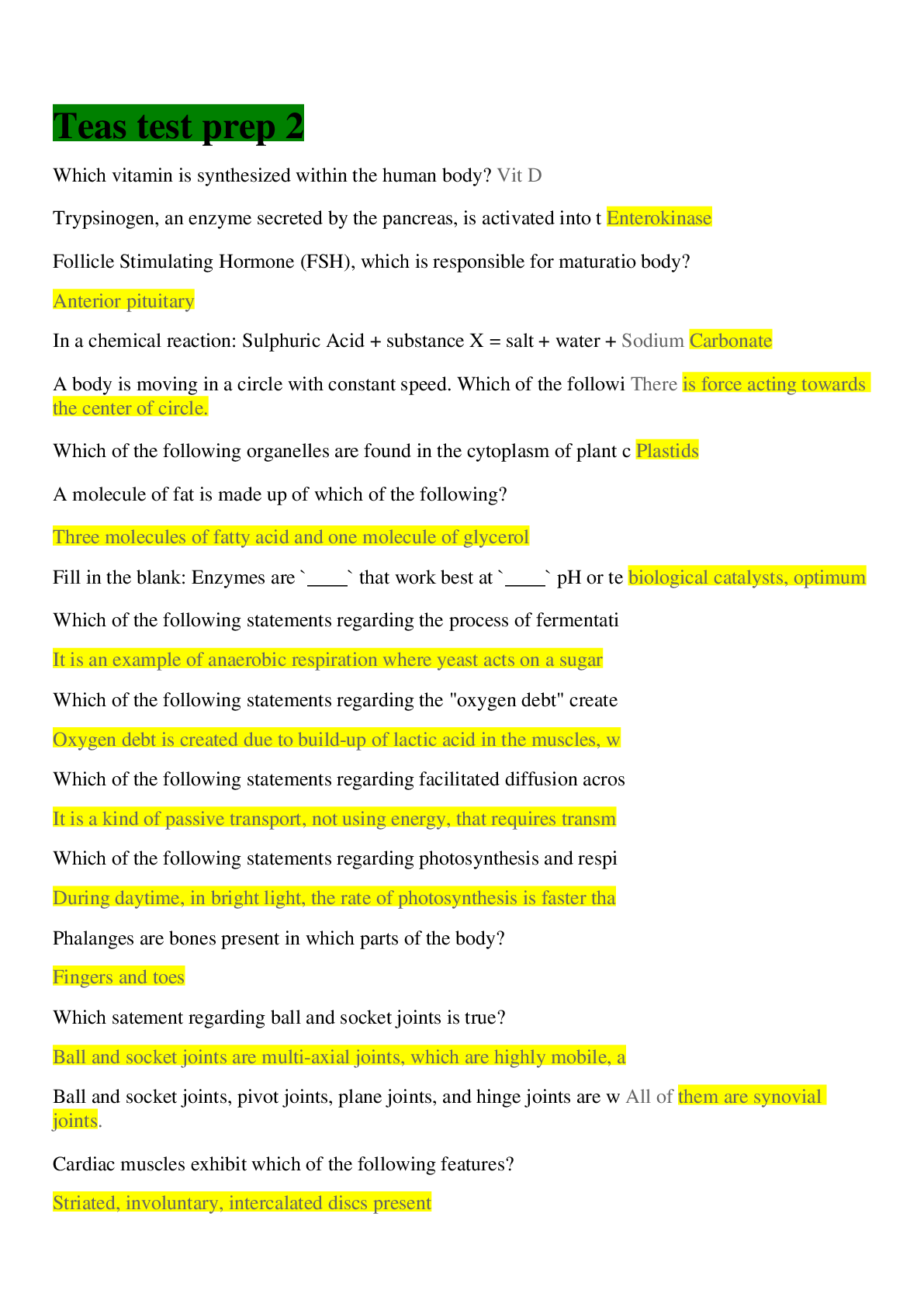
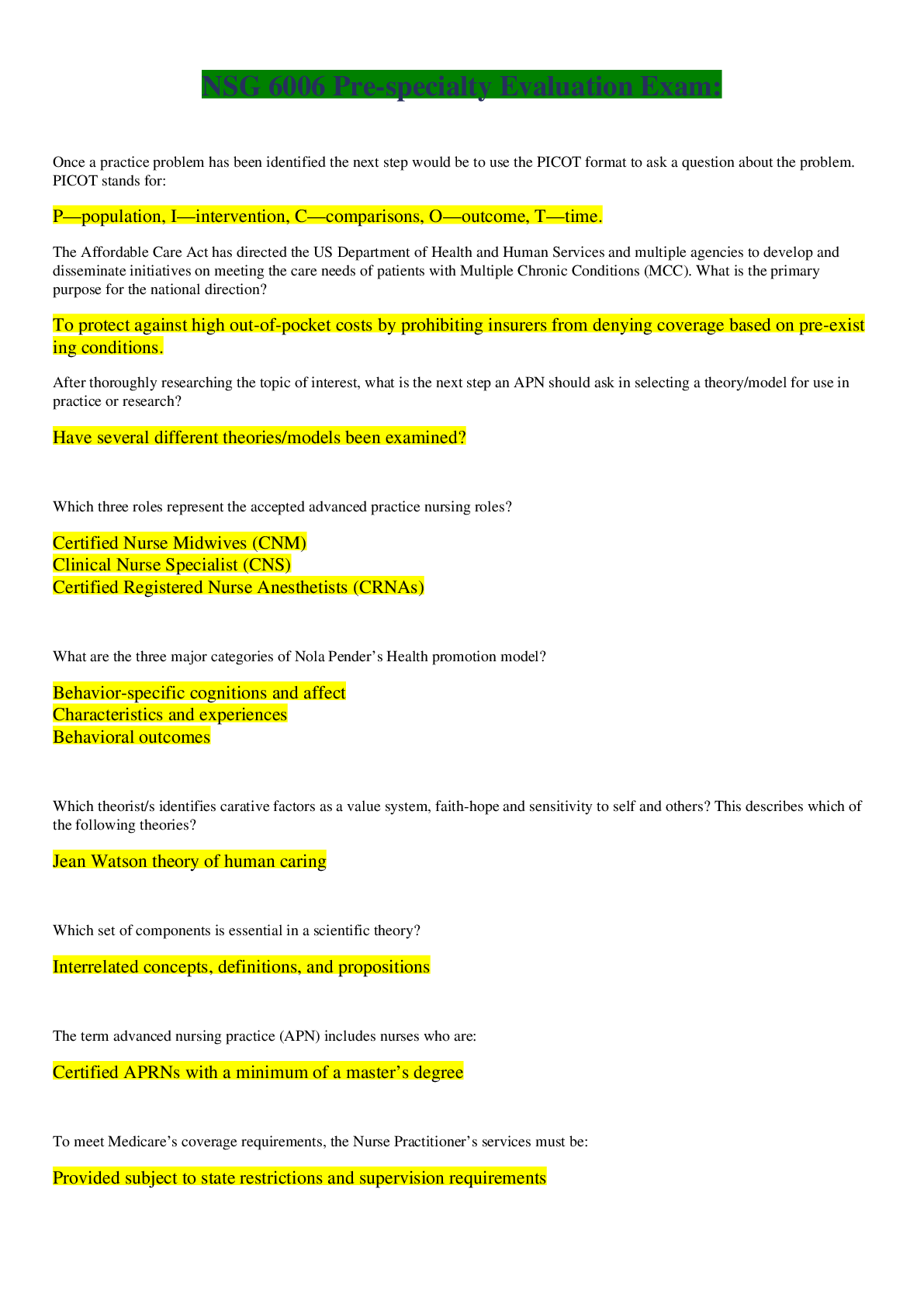
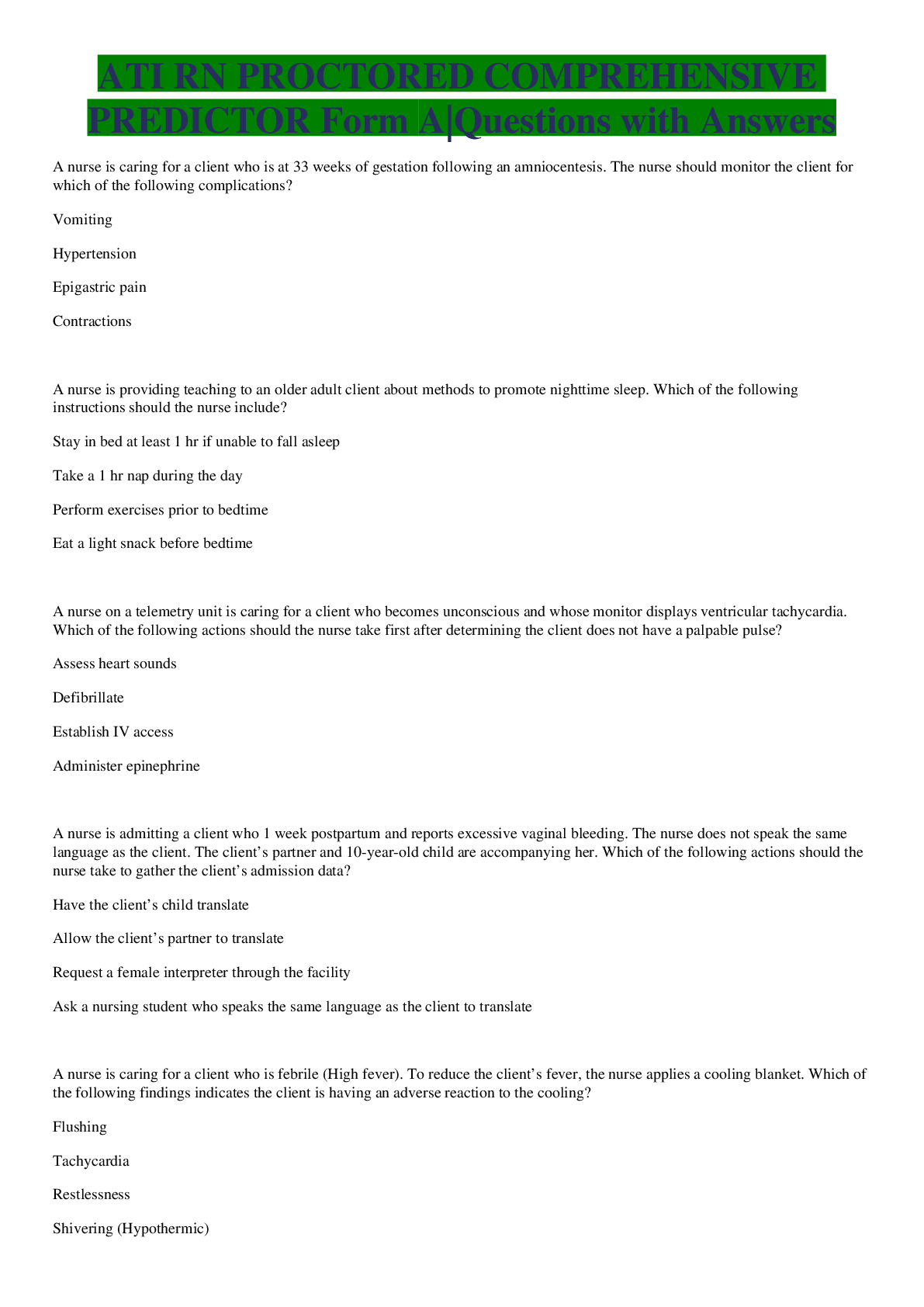
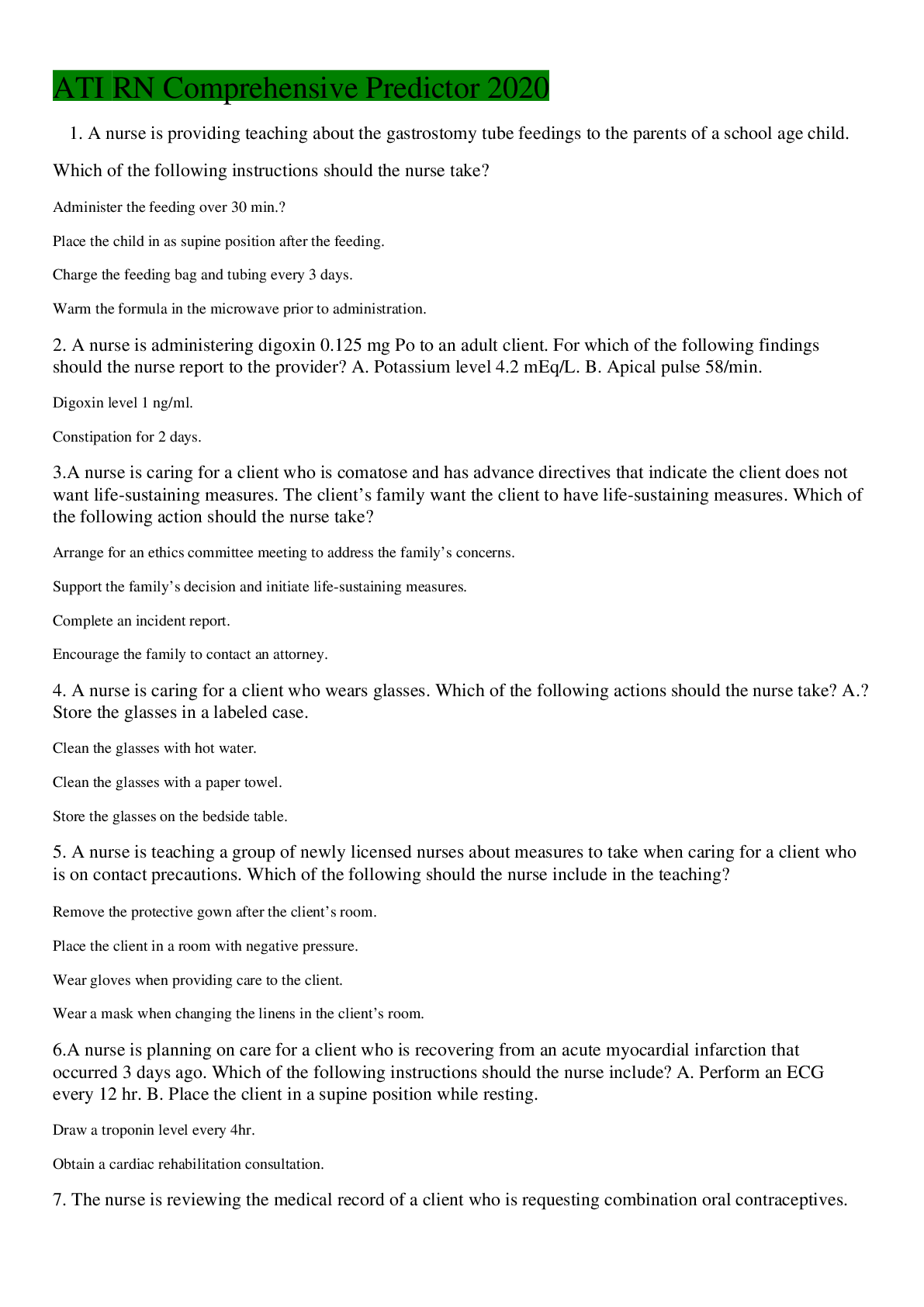



.png)
